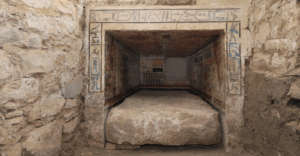Archaeologists May Have Found King Thutmose II’s Lost Tomb—A Discovery Hidden for Millennia!
Archaeologists may have discovered a second tomb of King Thutmose II in Egypt. Dr. Piers Litherland’s team believes the pharaoh’s remains were relocated due to flooding. The tomb is thought to be hidden beneath a 23-meter artificial mound in the Theban Necropolis near Luxor. Excavation is ongoing, as tunneling is too dangerous. The first tomb, found behind a waterfall, showed signs of royal burial with a decorated ceiling. An inscription suggests Queen Hatshepsut moved the remains. The discovery could provide insights into ancient burial practices. Experts hope to uncover artifacts and new historical details. If confirmed, it could be a major breakthrough in Egyptology.

Archaeologists May Have Found King Thutmose II’s Lost Tomb—A Discovery Hidden for Millennia!
This discovery comes shortly after Dr. Piers Litherland announced the finding of the first pharaoh’s tomb since Tutankhamun’s was revealed over a century ago. Speaking to The Observer, Dr. Litherland suggested that this second site could contain the mummified remains of Thutmose II.
Experts suspect that the first tomb was emptied and its contents relocated roughly six years after the pharaoh’s burial due to flooding.
Dr. Litherland and his team think the second burial site is concealed beneath a 23-meter (75 ft) artificial mound of limestone, ash, rubble, and mud plaster—intentionally shaped by the ancient Egyptians to blend into the mountainous landscape of the Western Valleys in the Theban Necropolis, near Luxor.
The initial tomb, discovered behind a waterfall, is believed to have been affected by flooding. While searching for it, archaeologists came across a posthumous inscription suggesting that Thutmose II’s remains had been moved to a second tomb, possibly by his wife and half-sister, Hatshepsut.
Currently, the British-Egyptian team is carefully excavating the site by hand, as tunneling into it has been deemed too risky. Dr. Litherland estimates it will take about a month to clear the mound.
The first tomb was located in an area traditionally associated with royal women, but the burial chamber itself was decorated—a sign of pharaonic status. Notably, part of the ceiling featured a blue background adorned with yellow stars, a design reserved exclusively for kings’ tombs.
Earlier this week, Dr. Litherland described the discovery as overwhelming, telling the BBC’s Newshour that stumbling upon something unexpected brings intense emotions and a sense of bewilderment.
Thutmose II is primarily known as the husband of Queen Hatshepsut, one of Egypt’s most renowned rulers and one of the few women to govern as pharaoh in her own right. He was also an ancestor of Tutankhamun, who ruled around 1493–1479 BC. The tomb of Tutankhamun was famously uncovered by British archaeologists in 1922.
If confirmed, this second tomb could provide critical insights into ancient Egyptian burial practices, particularly how royalty responded to environmental threats such as flooding. The presence of a hidden tomb beneath an artificial mound suggests a strategic approach to preserving the pharaoh’s remains and securing his passage to the afterlife.
The discovery also raises questions about whether other relocated royal burials remain undiscovered in the Theban Necropolis. Given Hatshepsut’s involvement in moving her husband’s remains, researchers may investigate whether similar protective measures were taken for other rulers of the New Kingdom.
Dr. Litherland’s findings have already sparked excitement among Egyptologists, with experts speculating that new artifacts, inscriptions, or burial goods might be recovered from the second tomb. If intact, these could shed light on Thutmose II’s reign and his relationship with Hatshepsut, who later ruled as a powerful pharaoh in her own right.
Further excavation efforts are expected to continue, with archaeologists hopeful that this second tomb could mark one of the most significant discoveries in Egyptology in recent years.
Check out TimesWordle.com for all the latest news
You must be logged in to post a comment.